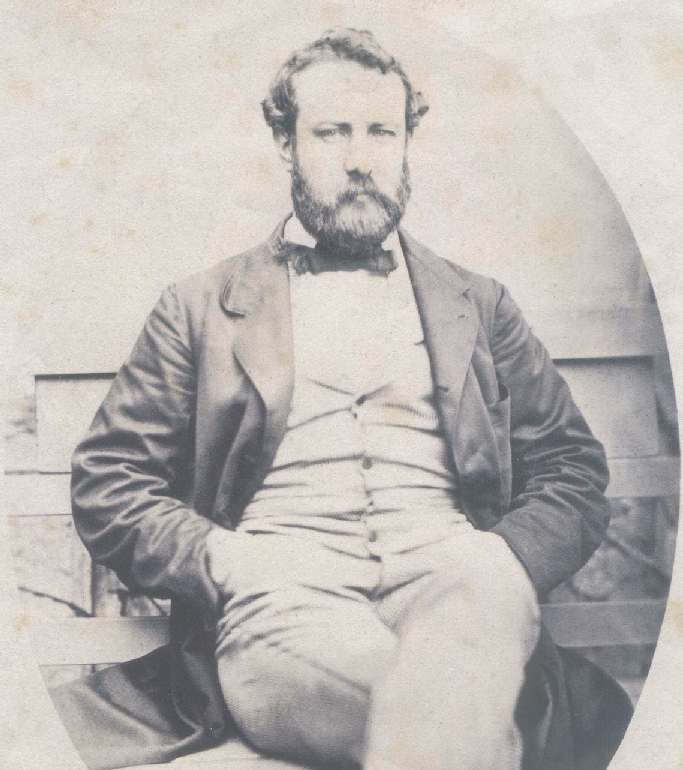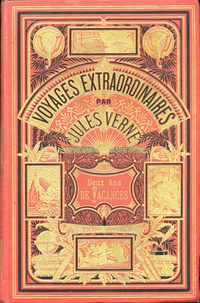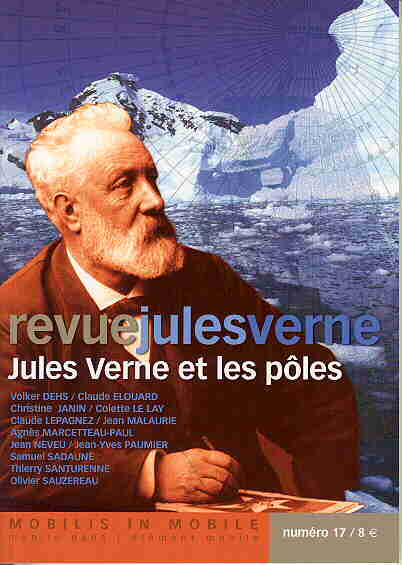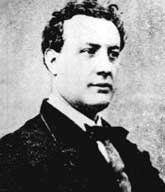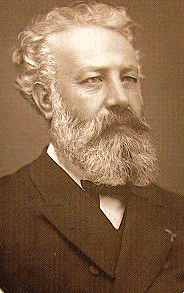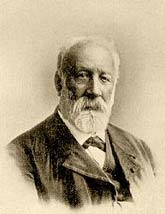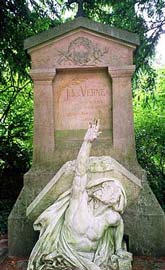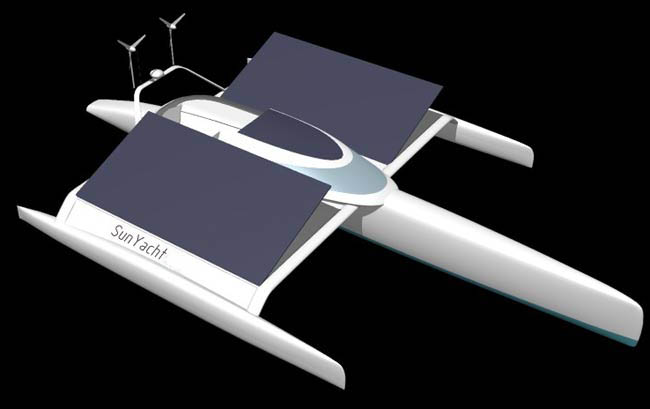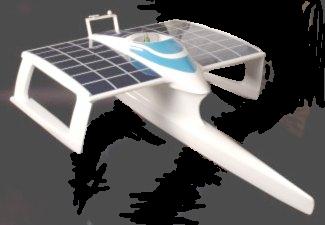|
|||||||||||||||||||||||||||||||||||||||||||||||||||||||||||||||||||||||||||||||||||||||||||||||||||||||||||||||||||||||||||||||||||||||||||||||||
|
Jules Gabriel Verne (February 8, 1828–March 24, 1905) was a very popular French author, the founding father of science fiction with H.G. Wells. Verne's stories, written for adolescents as well as adults. His stories caught the enterprising spirit of the 19th century, its uncritical fascination about scientific progress and inventions. His works were often written in the form of a travel book, which took the readers on a voyage to the moon in From the Earth to the Moon (1865) or to another direction as in A Journey to the Center of the Earth (1864). Many of Verne's ideas have been hailed as prophetic. Among his best-known books is the classic adventure story Around the World in Eighty Days (1873).
"Ah - what a journey - what a marvelous and extraordinary journey! Here we had entered the earth by one volcano, and we had come out by another. And this other was situated more than twelve hundred leagues from Sneffels, from that drear country of Iceland cast away on the confines of the earth... We had abandoned the region of eternal snows for that infinite verdure, and had left over our heads the gray fog of the icy regions to come back to the azure sky of Sicily!" (from A Journey to the Center of the Earth, 1864)
Verne was a pioneer of the science-fiction genre, noted for writing about cosmic, atmospheric, and underwater travel long before air travel and submarines were commonplace and before practical means of space travel had even been devised.
Jules Verne
Jules Verne was born and raised in the port of Nantes. His father was a prosperous lawyer. To continue the practice, Verne moved to Paris, where he studied law. His uncle introduced him into literary circles and he started to published plays under the influence of such writers as Victor Hugo and Alexandre Dumas (fils), whom Verne also knew personally. Verne's one-act comedy The Broken Straws was performed in Paris when he was 22. In spite of busy writing, Verne managed to pass his law degree. During this period Verne suffered from digestive problems which then recurred at intervals through his life.
In 1854 Charles Baudelaire translated Edgar Allan Poe's works into French. Verne became one of the most devoted admirers of the American author, and wrote his first science fiction tale, 'An voyage in Balloon' (1851), under the influence of Poe. Later Verne would write a sequel to Poe's unfinished novel, Narrative of a Gordon Pym, entitled The Sphinz of the Ice-Fileds (1897). When his career as an author progressed slowly, Verne turned to stockbroking, an occupation which he held until his successful tale Five Weeks in a Balloon (1863) in the series VOYAGES EXTRAORDINAIRES. Verne had met in 1862 Pierre Jules Hetzel, a publisher and writer for children, who started to publish Verne's 'Extraordinary Journeys'. This cooperation lasted until the end of Verne's career. Hetzel had also worked with Balzac and George Sand. He read Verne's manuscripts carefully and did not hesitate to suggest corrections. One of Verne's early works, Paris in the Twentieth Century, was turned down by the publisher, and it did not appear until 1997 in English.
BIOGRAPHYEarly years
Verne was born in Nantes, France, to Pierre Verne, an attorney, and his wife, Sophie. The oldest of the family's five children, Jules spent his early years at home with his parents, in the bustling harbour city of Nantes. In summer, the family lived in a country house just outside the city, on the banks of the Loire River. The sight of the many ships navigating the river sparked Jules' imagination, as he describes in the autobiographical short story "Souvenirs d'Enfance et de Jeunesse". At the age of nine, Jules and his brother Paul, of whom he was very fond, were sent to boarding school at the Saint Donatien College (Petit séminaire de Saint-Donatien) in Nantes.
There Jules studied Latin, which he later used in his short story "Le Mariage de Monsieur Anselme des Tilleuls" (mid 1850s). One of his teachers may also have been the French inventor Brutus de Villeroi, who was professor of drawing and mathematics at the college in 1842, and who later became famous for creating the US Navy's first submarine, the USS Alligator. De Villeroi may naturally have been an inspiration for Jules Verne's conceptual design for the Nautilus in 20,000 Leagues Under the Sea, although no direct exchanges between the two men have been recorded.
Verne's second French biographer, Marguerite Allotte de la Fuye, formulated the myth that Verne's fascination with adventure asserted itself at an early age to such a degree that it inspired him to stow away on a ship bound for Asia, but that Jules's voyage was cut short when he found his father waiting for him at the next port.
Literary debut
After completing his studies at the lycée, Verne went to Paris to study for the bar. About 1848, in conjunction with Michel Carré, he began writing librettos for operettas. For some years his attentions were divided between the theatre and work, but some travellers' stories which he wrote for the Musée des Familles seem to have revealed to him the true direction of his talent: the telling of delightfully extravagant voyages and adventures to which cleverly prepared scientific and geographical details lent an air of verisimilitude.
When Verne's father discovered that his son was writing rather than studying the law, he promptly withdrew his financial support. Consequently, he was forced to support himself as a stockbroker, which he hated, although he was somewhat successful at it. During this period, he met the authors Alexandre Dumas and Victor Hugo, who offered him some advice on his writing.
Also during this period he met Honorine de Viane Morel, a widow with two daughters. They got married on January 10, 1857. With her encouragement, he continued to write and actively try to find a publisher. On August 3, 1861, their son, Michel Jules Verne, was born. A classic enfant terrible, he married an actress over Verne's objections, had two children by his underage mistress, and buried himself in debts. The relationship between father and son improved as Michel grew older.
Typical Hetzel front cover for Jules Verne edition - Voyages Extraordinaires
Verne's situation improved when he met Pierre-Jules Hetzel, one of the most important French publishers of the 19th century, who also published Victor Hugo, George Sand, and Erckmann-Chatrian, among others. When they met, Verne was 35 and Hetzel 50, and from then, until Hetzel's death, they formed an excellent writer-publisher team. Hetzel's advice improved Verne's writings, which until then had been rejected and rejected again by other publishers. Hetzel read a draft of Verne's story about the balloon exploration of Africa, which had been rejected by other publishers on the ground that it was "too scientific". With Hetzel's help, Verne rewrote the story and in 1863 it was published in book form as Cinq semaines en ballon (Five Weeks in a Balloon). Acting on Hetzel's advice, Verne added comical accents to his novels, changed sad endings into happy ones, and toned down various political messages.
From that point on, and up to years after Verne's death, Hetzel published two or more volumes a year. The most successful of these include: Voyage au centre de la terre (Journey to the Center of the Earth, 1864); De la terre à la lune (From the Earth to the Moon, 1865); Vingt Mille Lieues sous les mers (20,000 Leagues Under the Sea, 1869); and Le tour du monde en quatre-vingts jours (Around the World in Eighty Days), which first appeared in Le Temps in 1872. The series is collectively known as "Les voyages extraordinaires" ("Extraordinary voyages"). Verne could now make a living by writing. But most of his wealth came from the stage adaptations of Le tour du monde en quatre-vingts jours (1874) and Michel Strogoff (1876), which he wrote together with Adolphe d'Ennery. In 1867 he bought a small ship, the Saint-Michel, which he successively replaced with the Saint-Michel II and the Saint-Michel III as his financial situation improved. On board the Saint-Michel III, he sailed around Europe. In 1870, he was appointed as "Chevalier" (Knight) of the Légion d'honneur. After his first novel, most of his stories were first serialised in the Magazine d'Éducation et de Récréation, a Hetzel biweekly publication, before being published in the form of books. His brother, Paul Verne, contributed to the 40th French climbing of the Mont-Blanc, added to his brother's collection of short stories Doctor Ox in 1874. Verne became wealthy and famous. He remains the most translated novelist in the world, according to UNESCO statistics.
|
|
LEG |
NAUTICAL MILES |
BUNKERING |
WAYPOINT |
SUNSHINE DAYS |
|
- |
- |
- |
- |
- |
|
|
- |
- |
- |
- |
|
- |
- |
FILL UP |
00.00 |
|
|
1 |
729 |
- |
1.90 |
|
|
2 |
3,154 |
- |
8.21 |
|
|
3 |
1,182 |
1 |
3.00 |
|
|
4 |
970 |
- |
2.45 |
|
|
5 |
3,640 |
- |
9.48 |
|
|
6 |
1,423 |
- |
3.71 |
|
|
7 |
410 |
- |
1.07 |
|
|
8 |
1,886 |
1 |
4.91 |
|
|
9 |
340 |
- |
0.88 |
|
|
10 |
724 |
- |
1.89 |
|
|
11 |
1,572 |
- |
4.09 |
|
|
12 |
1,881 |
- |
4.90 |
|
|
13 |
2,109 |
1 |
5.49 |
|
|
14 |
698 |
- |
1.82 |
|
|
15 |
670 |
- |
1.75 |
|
|
16 |
1,111 |
- |
2.89 |
|
|
17 |
170 |
- |
0.44 |
|
|
18 |
940 |
|
3.01 |
|
|
- |
- |
- |
- |
- |
|
- |
23,609 |
- |
RUNTIME DAYS @ 12.5kts |
78.70 |
|
- |
- |
(ADD 3 DAYS) |
RUNTIME DAYS @ 13kts |
75.67 |
|
- |
- |
- |
- |
- |
|
- |
- |
(ADD 4 DAYS) |
14 KNOTS AVE INC |
70.26 |
|
- |
- |
- |
AT 15 KNOTS AVE |
65.58 |
|
- |
- |
- |
AT 16 KNOTS AVE |
61.48 |
SELECTED WORKS
Verne wrote 54 novels in total. Some of the better known are:
-
Five Weeks in a Balloon (Cinq Semaines en ballon, 1863)
-
Paris in the 20th Century (Paris au XXe Siecle, 1863, not published until 1994)
-
Journey to the Center of the Earth (Voyage au centre de la Terre, 1864)
-
The English at the North Pole (Les Anglais au pôle Nord, 1864)
-
From the Earth to the Moon (De la terre à la lune, 1865)
-
The Desert of Ice (Le Désert de glace, 1866)
-
In Search of the Castaways or The Children of Captain Grant (Les Enfants du capitaine Grant, 1867-1868)
-
A Floating City (Une ville flottante, 1871)
-
Around the World in Eighty Days (Le Tour du Monde en quatre-vingts jours, 1872)
-
Dr. Ox's Experiment (Une Fantaisie du Docteur Ox, 1872)
-
The adventures of three englishmen and three russians in South Africa (Aventures de trois Russes et de trois Anglais, 1872 )
-
20,000 Leagues Under the Sea (Vingt mille lieues sous les mers, 1873)
-
Around The Moon (Autour de la lune, a sequel to From the Earth to the Moon, 1873)
-
The Fur Country (Le Pays des fourrures, 1873)
-
Mysterious Island (L’île mysterieuse, 1874)
-
Survivors of Chancellor (1875 )
-
Michael Strogoff (Michel Strogoff, 1876)
-
Hector Servadac (1877)
-
The Child of the Cavern, also known as The Black Diamonds or The Black Indies (Les Indes noires, 1877)
-
A Captain at fifteen (Un Capitaine de quinze ans, 1878)
-
The 500 Millions of Begum (Les Cinq cents millions de la Bégum, 1879)
-
The steam house (La Maison à vapeur, 1879)
-
The giant raft (La Jangada, 1881)
-
The Green Ray (Le Rayon vert, 1882)
-
The headstrong turk (1883)
-
The vanished diamond (L’Étoile du sud, 1884)
-
The archipelago on fire (L’Archipel en feu, 1884)
-
Matthias Sandorf (1885)
-
Robur the Conqueror or The Clipper of the Clouds (Robur-le-Conquérant, 1886)
-
Ticket no. '9672' (Un Billet de loterie, 1886 )
-
Texar's Revenge or North Against South (Nord contre Sud, 1887)
-
The flight to France (Le Chemin de France, 1887)
-
Two Years' Vacation (Deux Ans de vacances, 1888)
-
Castle of the Carpathians (Le Château des Carpathes, 1892)
-
The Mighty Orinoco (Le Superbe Orénoque, 1894)
-
Propeller Island (L’Île à hélice, 1895)
-
The Purchase of the North Pole (Sans dessus dessous, the second sequel to From the Earth to the Moon, 1895)
-
Clovis Dardentor (1896)
-
The Sphinx of the Ice Fields or An Antarctic Mystery (Le Sphinx des glaces, a sequel to Edgar Allan Poe's The Narrative of Arthur Gordon Pym, 1897)
-
The Superb Orinoco (1897)
-
The village in the Tree Tops (Le Village aérien, 1901)
-
Master of the World (Maître du monde, sequel to Robur The Conqueror, 1904)
-
Invasion of the Sea (L’Invasion de la mer, 1904)
-
The Lighthouse at the End of the World (Le Phare du bout du monde, 1905)
-
The Chase of the Golden Meteor (La Chasse au météore, 1908)
-
The Danube Pilot (Le Pilote du Danube, 1908)
-
The survivors of the 'Jonathan' (Le Naufrages du Jonathan, 1909)
For further reading: Jules Verne by Kenneth Allott (1940); Jules Verne and His Works by I.O. Evans (1966); Jules Verne by B. Becker (1966); Le Trés Curieux Jules Verne by M. More (1969); The Political and Social Ideas of Jules Verne by Jean Chesneaux (1972); Jules Verne by Jean-Jules Verne (1976), Jules Verne by Peter Costello (1978); Jules Verne: A Primary and Secondary Bibliography by Edward J. Gallagher, Judith Mistichelli and John A. Van Eerde (1980); Jules Verne Rediscovered by Arthur B. Evans (1988); Jules Verne's Journey to the Centre of the Self by William Butcher (1990); The Mask of the Prophet by Andrew Martin (1990); Jules Verne: An Exploratory Biography by Herbert R. Lottman (1997) - Suom: Verneltä on suomennettu useita kymmeniä teoksia. Suomentajana on ollut mm. kirjailija Joel Lehtonen.
LINKS:
"Jules Verne", Washington Post Bookworld, March 2006.
Searchable Collection of Jules Verne works and quotations
Online editions of works, in HTML
Jules Verne - easy-to-read HTML format of Verne's books.
Jules Verne at the Internet Book List
Works by Jules Verne at Project Gutenberg
Zvi Har'El's Jules Verne Collection, including the Jules Verne Virtual Library, with free online versions of 51 of Jules Verne's novels translated into eight languages.
Jules Verne's novels online in English and French
Jules Verne French Stamps - 2005, "Les Voyages Extraordinaires"
Jules Verne at the Internet Speculative Fiction Database
JULES
VERNE (SAILING) TROPHY HOLDERS:
2017 – Francis
Joyon / IDEC SPORT (31.5m) – 40:23:30:30
2012 – Loïck
Peyron / Banque Populaire V (40m) – 45:13:42:53
2010 – Franck
Cammas / Groupama 3 (31.5m) – 48:07:44:52
2005 – Bruno
Peyron / Orange II (36.8m) – 50:16:20:04
2004 – Olivier
De Kersauson / Geronimo (33.8m) – 63:13:59:46
2002 – Bruno
Peyron / Orange (32.8m) – 64:08:37:24
1997 – Olivier
De Kersauson / Sport-Elec (27.3m) – 71:14:22:08
1994 – Peter
Blake, Robin Knox-Johnston / Enza New Zealand (28m) – 74:22:17:22
1993 – Bruno
Peyron / Commodore Explorer (28m) – 79:06:15:56
LIST OF JULES VERNE (SAILING) ATTEMPTS:
2021
- Charles
Caudrelier / Gitana Team 1st attempt - Maxi Edmond de Rothschild
& Franck Cammas
2020 - Thomas Coville
/ Sodebo Ultim 3 1st attempt - foiling trimaran
2019, 2015 - Yann
Guichard / 3 attempts - Spindrift
2015 - Dona
Bertarelli & Yann Guichard / 1 attempt - Spindrift
2011 - Pascal
Bidégorry / 1st attempt - Bank Populaire
2003 - Ellen
MacArthur / 1 attempt - Kingfisher II
1998 - Tracy
Edwards / 1 attempt - Royal Sun Alliance
CONTACT THE (FRENCH) SAIL RACE ORGANIZERS
ASSOCIATION
TOUR DU MONDE EN 80 JOURS
Musée de la Marine
Palais de Chaillot
17 place du Trocadéro
75016 Paris
Jules Verne was the author of many adventure stories:
1 Twenty
Thousand Leagues Under the Sea
2 Around
the World in Eighty Days
3 Journey
to the Center of the Earth
4 The
Mysterious Island (Extraordinary Voyages #12)
5 From
the Earth to the Moon
6 Michael
Strogoff (Extraordinary Voyages, #14)
7 In
Search of the Castaways; or the Children of Captain Grant
(Extraordinary Voyages, #5)
8 Five
Weeks in a Balloon
9 Round
the Moon (Extraordinary Voyages, #7)
10 Adrift
in the Pacific: Two Years Holiday (Extraordinary Voyages, #32)
11 The
Master of the World (Extraordinary Voyages, #53)
12 The
Adventures of Captain Hatteras
13 Les
Tribulations d'un Chinois en Chine; The Tribulations of a Chinese
in China (Extraordinary Voyages, #19)
14 The
Lighthouse at the End of the World
15 Mathias
Sandorf (Extraordinary Voyages, #27)
16 Off
On A Comet (Extraordinary Voyages, #15)
17 Los
quinientos millones de la Begún (The five
hundred million of the Begún)
18 Facing
the Flag (Extraordinary Voyages, #42)
19 Un
capitán de quince años (A fifteen year old
captain)
20 El
Testamento de un excentrico (The Testament of an
eccentric)
Healthier alternative tastes for adventure capitalists
Solar Red | Solar Cola | Solar Crush | Solar Citrus | Solar Spice
This website is Copyright © 1999 & 2021. The bird logos and name Solar Navigator and Solar Cola are trademarks. All rights reserved. All other trademarks are hereby acknowledged. Max Energy Limited is an environmental educational charity.
